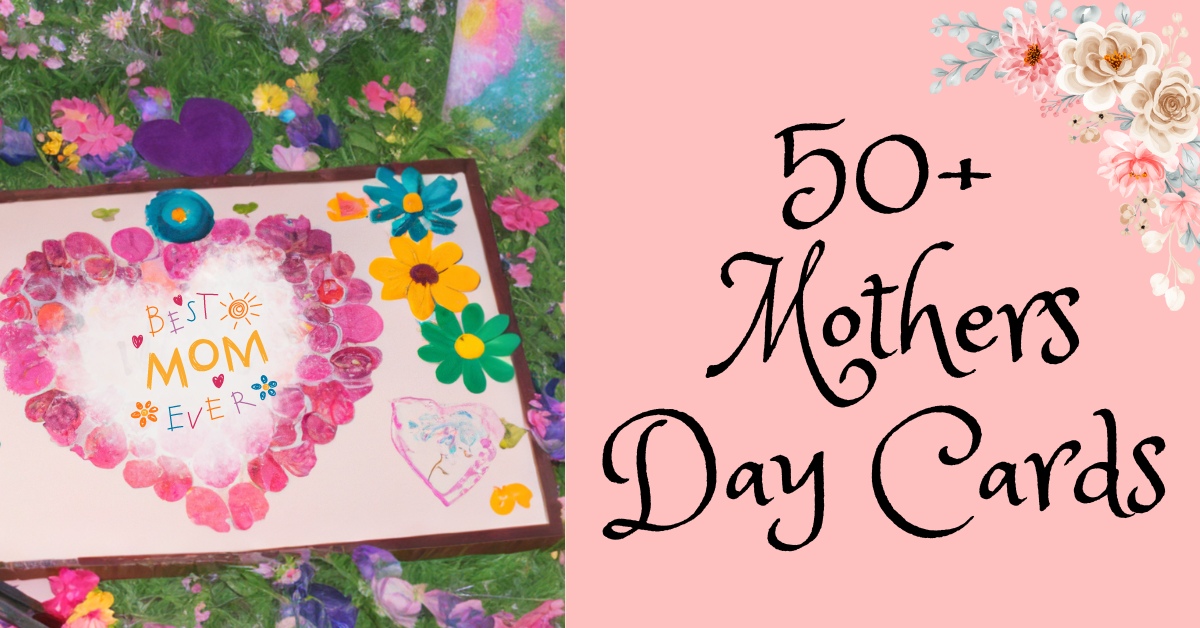Hebrew Holiday Rosh Hashanah. Jewish New Year. Healthy Jewish Recipes.
The Jewish year of holidays starts with Rosh Hashanah
All holidays of a Jewish calendar are connected with Jewish religion to certain extend (some less, others more). Most of them come from the Old Testament. We celebrate Jewish holidays, and though we might not celebrate it the right traditional way, we cook traditional Jewish recipes, we serve the festive table and sit around. We sing holiday songs and play holiday games. It gives us a strong feeling of belonging to Jewish family, of remembering our roots, of being proud of what we are and where we came from.
The Jewish year of holidays starts with Rosh Hashanah (in Hebrew: ראש השנה. Remember, we read and write from right to left in Hebrew). The literal translation means “Head of the Year”. It is observed on the first day of Tishrei. Though Tishrei is not the first, but the seventh month of a Hebrew calendar, it is viewed nowadays as de facto beginning of the year, because this is when the numbered year changes. It is not as complicated as it might seem.
Hebrew Calendar
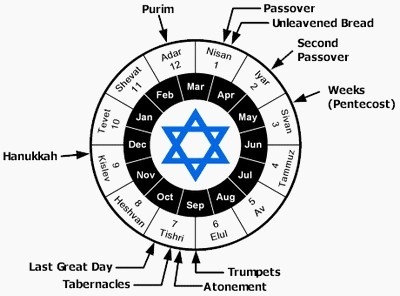
Hebrew Calendar.
The Jewish calendar is a lunisolar calendar, based on twelve lunar months of twenty-nine or thirty days.
In order to synchronize the twelve lunar cycles with the slightly longer solar year, one more month, an intercalary lunar month is added once every two to three years (usually on a leap year). The twelve regular months are: Nisan (30 days), Iyar (29 days), Sivan (30 days), Tammuz (29 days), Av (30 days), Elul (29 days), Tishrei (30 days), Cheshvan (29 or 30 days), Kislev (29 or 30 days), Tevet (29 days), Shevat (30 days), and Adar (29 days). In the leap years an additional month, Adar I (30 days) is added after Shevat, and the regular Adar is referred to as "Adar II".
Each Jewish lunar month starts with the new moon. The Bible designates a spring month Nisan as the first month of the year, because life awakens in spring. The first holiday of spring Pesach (Passover), besides being the time when we celebrate Exodus of Jews from Egypt slavery, is also associated with the barley harvest, so the leap-month of Adar I, mentioned above is intercalated to keep this festival in the northern hemisphere's spring season.
Rosh Hashanah, "the head of the year", is celebrated in the month of Tishrei (seventh month of Hebrew calendar), and it would be more correct to call it "the new year for years”, as it changes the number of the year. That’s why most Jews today view Tishrei as the beginning of the year.
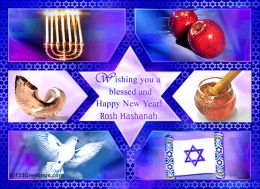
Rosh Hashanah marks the beginning of the Jewish year (number) and the period considered the High Holy Days.
Important: Jewish Holidays begin at sunset on the evening preceding the holiday.
“And there was evening and there was morning, one day”. Genesis, Chapter1.
Some English translations give “a first day”, but actually In Hebrew it is like this:
וַיְהִי-עֶרֶב וַיְהִי-בֹקֶר, יוֹם אֶחָד , i.t., one day.
So, Hebrew’s “tomorrow” starts at sunset of “today”.
Rosh Hashanah dates:
2010: September 9, 10 (Thurs. & Fri.) It will start Jewish Year of 5771.
2011: September 29, 30 (Thurs. & Fri.) It will start Jewish Year of 5772.
2012: September 17, 18 (Mon. & Tues.) It will start Jewish Year of 5773.
2013: September 5, 6 (Thurs. & Fri.) It will start Jewish Year of 5774.
Rosh Hashanah is believed to represent the creation of the World, or Universe. However the more precise meaning of Rosh Hashanah is to commemorate the creation of man.
We know, that New Year in many cultures is celebrated with huge celebrations, wild parties, festivals and carnivals. Not the Jewish New Year. Unlike many cultures, it isn’t celebrated with wild partying. This holiday is a time of prayer and reflections. It’s a time to ask for forgiveness for one’s actions over the past year, and to plan a fresh start in the coming one.
Rosh Hashanah is also called "the day of judgment”, it is the beginning of the ten days of atonement.
On Rosh Hashanah, all mankind is judged by God. His judgment is based on our lives of the year before. But the judgment is not final. The days between Rosh Hashanah and Yom Kippur give us a time to change the judgment for good. We are given the chance to improve our coming year.
On Rosh Hashanah we wish each other "L'Shanah Tovah Tiktevuh" (may you be written in for a good year), or we say “Gmar Hatimah Tovah” (good final record), . But Rosh HaShanah is not the end of the judgment, it is only on Yom Kippur that the judgment is made final.
Shofar

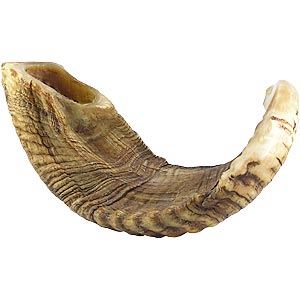

Shofar, Tashlich and Slichot.
Rosh Hashanah celebration begins with the blowing of the shofar (the ram’s horn) in synagogue. This marks the start of the ten High Holy Days of the Jewish calendar.
Shofar sounds something like a trumpet, but unlike trumpet, shofar does not have a mouthpiece. It is very hard to blow the shofar and it takes a lot of practice to do it.
There are several interpretations of reasons why shofar is blown on Rosh Hashanah.
It is like a wake up call to people, to make them think about what good and bad they did, to encourage them for life improvement.
Also, the sound of a shofar reminds Jewish people of ten commandments that God gave them on Mt.Sinai (the sound of a shofar was heard at that time).
There are three types of shofar blasts that are heard during Rosh Hashanah.
Tekiah- one long blast;
Shevarim- three short blasts:
Terua- nine short fast blasts.
There is another interesting tradition, called “Tashlich” (translates as “casting off”), which is performed on the afternoon of the first day of Rosh Hashanah or on the second day, if Rosh Hashanah falls on Saturday. People go to a creek, or a river (any running water) and shake off their pockets, empty dirt out of the pockets, as if symbolically tossing away their sins. If you are religious, you will say a special prayer and shake off bread crumbs brought for this purpose.
Another tradition is to ask for forgiveness at this time (Slichot, from the word "sliha"- forgive). We should ask for forgiveness anyone whom we might have hurt and also we should forgive everyone who might have hurt us.
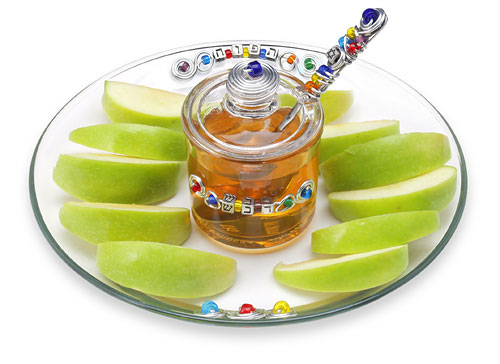
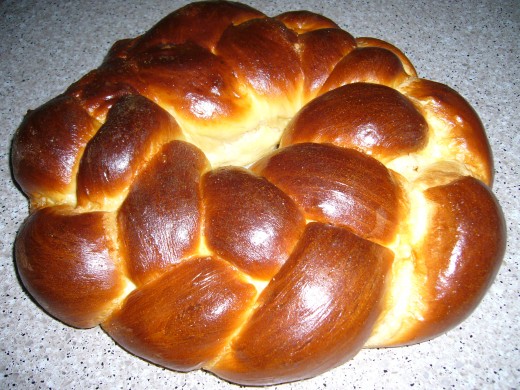
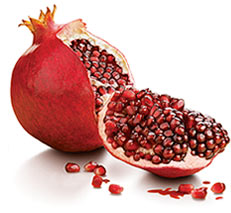
It is about food too.
As any holiday of a Jewish calendar, Rosh Hashanah is about food too! Jewish food traditions are considered the healthiest and there is a good reason to it. Jewish religion forbids eating fat unhealthy foods, meat of "dirty" animals who survive on eating carrion. Also according Jewish food laws you cannot mix meat and diary products which makes good sense, because our body needs different time to consume them.
Rosh Hashanah festive table should contain mostly sweet types of food, to symbolize with sweet year to come. The absolute must is honey! Honey represents good living and wealth. The Land of Israel is often called the land of "milk and honey" in the Bible.
We dip apple wedges into honey, it is the most traditional snack of this time. We also dip pieces of challah into honey.
Challah is a special traditional braided Jewish bread that is served at the Jewish dinner table during ceremonial gatherings, but during Rosh Hashanah, it is often baked into round shape to serve as symbol of the cyclical nature of the year. Raisins are often added to signify a sweet new year. The pieces of challah are dipped in honey to symbolize the sweetness we wish to take place in the coming year.
Another Rosh Hashanah food tradition is to eat a "new fruit" – meaning, a fruit that has recently come into season. A pomegranate is often used as this new fruit. In the Bible, the Land of Israel is praised for its pomegranates. It is also said that this fruit contains 613 seeds just as there are 613 mitzvot (law of Bible). Another symbol of eating pomegranate during Rosh hashanah is that we wish that our good deeds in the coming year will be as plentiful as the seeds of the pomegranate.
"Rosh HaShanah literally means "head of the year" in Hebrew. For this reason it is traditional to serve fish with a head during the Rosh HaShanah holiday meal. It is customary for the head of the fish to be placed in front of the head of household ("May it be your will that we be like the head (leaders) and not like the tail (followers). Fish is also eaten because it is an ancient symbol of fertility and abundance. Since its eyes are always open, the creature represents knowledge.
In general, fish is the most traditional food on a Jewish table.
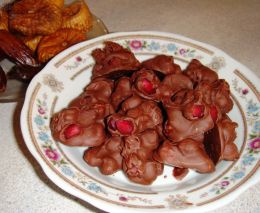
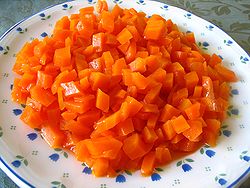
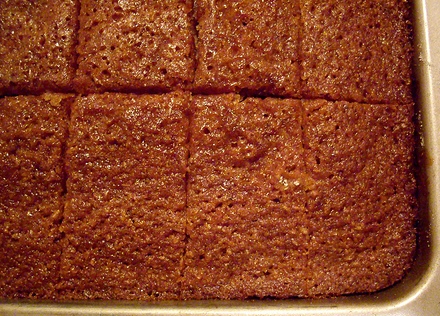
My favorite recipes for Rosh Hashanah.
Pomegranate-Apple Salad
This fresh and light Pomegranate Apple Salad complements the spirit of the holiday by using the two fruits that traditionally symbolize Jewish New Year. It is very simple and fast to prepare.
Just chop one apple, seed one pomegranate (be careful, pomegranate juice leaves stains; use tips described here), open a jar of pineapple cuts (don’t use juice). Chop one or two celery stalks. Mix everything in a bowl and sprinkle Poppy seed Salad dressing on the top.
"Tsimmes"
"Tsimmes" is my my favorite side dish since my childhood. Basically, it is just chopped carrots slowly simmered with honey or sugar. My mother used to make it this way:
1. Peel and chop (or slice into 1/4" rounds) 2 lb of carrots; add water (just to cover); add 1/2 cup of honey; add 1 Tablespoon of Lemon juice; add salt to taste (also optionally, you may add 1 teaspoon of cinnamon). Mix everything in a large saucepan.
Later you will need 2 to 3 Tablespoons of butter.
2. Set the saucepan over medium-high flame and bring to a boil. Reduce heat to medium-low, cover and simmer, stirring occasionally, until the carrots are soft and cooked through (20 to 25 min, but it will depend on the size of carrot slices; you might need more cooking time).
3. Remove cover and increase heat to medium-high. Boil so that the liquid on the bottom will cook until it forms a glaze on the carrots.
4. Stir in the butter, adjust seasoning and serve.
"Lekach", Honey Cake.
This is something to make an effort, but it is fully worth it!
- Flour -- 3 1/2 cups
- Baking powder -- 1 1/2 teaspoons
- Baking soda -- 1/2 teaspoon
- Cinnamon -- 1 teaspoon
- Allspice -- 1/2 teaspoon
- Salt - 1/4 teaspoon
- Honey -- 1 cup
- Strong coffee, cooled -- 1/2 cup
- Vegetable oil -- 2 tablespoons
- Eggs -- 4
- Brown sugar -- 1 cup
3/4 cup of raisins, soaked in 3 tablespoon of Brandy or rum
1. Preheat oven to 325°F. In a large bowl, sift together the flour, baking powder, baking soda, cinnamon, allspice and salt.
2. In another bowl, mix together the honey, coffee and oil. Set both bowls aside.
3. Put the eggs and brown sugar to the bowl and beat with an electric mixer on medium speed until light and foamy (about 4-5 minutes).
4. Reduce the mixer speed to low and slowly add part of the flour mixture (about 1/3 of it), incorporating it fully. Next add half of the honey-mixture, also allowing it to be fully incorporated. Slowly add the same way another 1/3 of the flour mixture, then the remaining honey mixture and finish with the remaining flour mixture.
5. Gently fold in soaked raisins and brandy.
6. Pour the batter into a greased 9-inch round or square cake pan and bake for 45-55 minutes, or until a toothpick inserted into the center comes out clean.
7. Remove the cake to a counter and cool completely before removing from the pan. Cut into diamond-shaped slices and serve with hot coffee.
Traditional greetings for Rosh Hashanah
Shana Tova!- Good year!
Shana Tova Umetuka!- Good and sweet Year!
Le Shana Tova Tikatevu- May you be written for a good year!
Gmar Hatima Tova!- Good Final seal!
- Rosh Hashanah
Sari's hub about Rosh Hashana. - Alain Silberstein Hebraika Hebrew Calendar Watch
From 1994 comes the Hebraika watch showing the Hebrew calendar. An interesting timepiece with distinct niche appeal. Alain Silberstein is further working on more interesting calendar watches.











